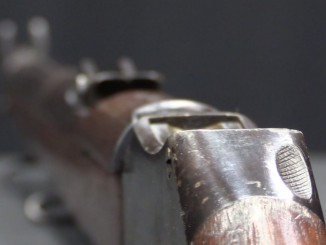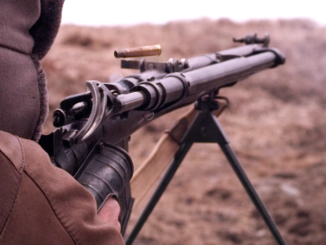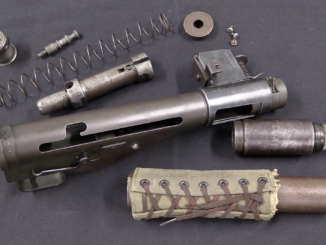The Lee Metford MkI had scarcely been introduced when it was modified into the MkI* pattern, This was quickly followed by the MkII and MkII*, the Lee Enfield MkI, and Lee Enfield MkI*. In essence, the changes were:
- Lee Metford MkI*: Change of sights to traditional barleycorn and V-notch, and removal of the manual safety
- Lee Metford MkII: Update to 10-round, double-feed magazine, move sling rearward, modify cleaning rod to clearing rod.
- Lee Metford MkII*: Addition of safety lever on cocking piece
- Lee Enfield MkI: Change from Metford rifling to Enfield
- Lee Enfield MkI*: Clearing rod removed




I’m familiar with the snap-on spring steel dust covers, but the one on your Mk. I appears to be held on with screws. Did that change too, or is the Mk. I just have its attachment lugs cut off?
A discussion in the House of Commons in February of 1891 brought out lots of comments about the Magazine Rifle Mark I (as it was then known). Some of this is clearly wrong in the light of later usage (e.g. the clear superiority of the Martini-Henry), but the transcript in Hansard does bring up some points about issue and use. In the autumn 1888, only 350 rifles were issued, and 50 carbines, “to various regiments and ships’ companies”. “Some were sent to India, some to Egypt, some to Canada.” The 2nd Bn of the Grenadier Guards were one unit carrying these. In the year 1890, 15,000 rifles were “placed in the hands of the troops”, at a cost of £5 5s each (this probably includes bayonet and sling, and possibly pouches and other ‘per weapon issued” items). This is still the weapon using the compressed black powder cartridge. Currently (February of 1891) 2,000 rifles are being issued to troops every week. A new model of the magazine rifle had been presented in December of 1890 for examination by the House; it holds more cartridges, so it’s presumbly the Mk II (I doubt Parliament was notified about the Mk I*). It’s mentioned that the current magazine rifles are available commercially: “I managed to find one for sale in London”, which implies they aren’t widely available. The commercial weapon cost 8 guineas, or £8 8s. An interesting mention: “the new smokeless powder, which we call “cordite””, was to enter large-scale production in April of 1891. Mr. Stanhope, the Secretary for War, noted, “The Martini-Henry was first produced on a large scale for £3 18s. 4d. In 1888–89 it cost £2 2s. 10d. The magazine rifle when first produced on a large scale at Enfield cost £5 5s.; during the current year ending on March 31st I believe the cost will turn out to be about £4.” He also says, “I happened to-day to be able to get information from a source which I know to be reliable, that for the French rifles produced on a much larger scale than we are manufacturing, the average manufacturing price of 3,000,000 rifles is 52f., but in this estimate no account is taken of the cost of laying down machinery. If you take that into consideration you must add 13f. to the cost of the weapon. On the other hand, the price does include the cost of the bayonet, which is 8f. or 9f. If you deduct that, you arrive at a cost for the rifle of about 57f.” Regarding ammunition cost: “… the price per 1,000 [cartridges], in the case of the magazine rifles to be manufactured in the coming year, will be £6 5s., while the contract price of the Martini-Henry ammunition has been £5 15s.” A British pound was worth about 25 French francs in 1891. So the “bare” French rifle is about £2 6s.
Interesting numbers.
I once tried to compare the cost of British interwar rifles with other countries.
It turned out that the English rifle was, if not the cheapest, then one of them.
Only a military edition Mauser was cheaper. But I didn’t know the price of British military-made rifles.
Considering the quite decent efficiency of these rifles. And especially the ease with which the production of these rifles was deployed almost anywhere, IMHO this is the best bolt rifle of the Second World War.
I had a Mk 3* w/ the cutoff, shouldn’t have sold it, but there was a lass…
What’s w/ the videos being posted to YouTube a day before they’re posted here?
re: …videos being posted to YouTube a day before they’re posted here?
That’s less of an issue than the YT vids that never show up here, like the recent Tucker#1.
Stupid question: How many British soldiers accidentally shot each other in the knees before the manual safety catch was put back into the design?
You really need to watch British Muzzleloader’s videos about the period drill. Rob clearly demonstrated this was not an issue with the proper use of the cut-off.
I take it to mean the magazine cutoff is on and the chamber is empty when the user is at rest and that the user does not ever load the chamber until the fighting actually starts. I want to add, however, that no procedure or product is completely idiot-proof.
I never heard of English rifle safety troubles.
Broken cases on old rifles, yes.
And about the shot in the knees, no.
I would love to see you apply your research and writing skills to a new volume (or volumes) about the Lee rifles — something between Skennerton and Stratton, and updated with the latest knowledge.
The British at this time seem to have been most thorough in marking each and every change to this rifle design.
This got me thinking about the M1 Garand. Throughout its life, it was always the M1. But aside from minor production variations, a major change came when the original gas trap system was replaced by the gas port system. Surely the latter, which was a major difference, should have been the M1A1? Can anyone shed light on this?
Ruperts shot in the back (or fragged) probably counts as “natural causes”
Squaddies shot in the knee…
Hmm, if that actually happened, it would suggest a mechanical problem.
Either that, or Private Snuffy ALWAYS keeps his itchy finger on the trigger, even when Sergeant Rock tells him to keep his fingers to himself.
I guess that the rapid changes to the issued pattern, probably reflect the development of the technology.
At least the Lee with the box magazine was at the.bleeding edge.
Double stack mags were a Mauser development of the early to mid 1890s. They were something that the Springfield prototypes of 1902 still hadn’t caught up with (bastard spawn of a drunken one night stand between a krag &jorgensen and an 1892 Mauser).
The comparison with the gas trap and gas port Garands, is fair
The Garand was bleeding edge too, in its day
Keith,
As you say, the Lee Metford was advanced for its day. It is therefore understandable that the powers that be would get some things wrong. Hence the decision to delete the safety catch, and keep the volley fire sights. I think I know which one of those has more practical use.
As for the Long Lee Enfield, it is quite a fine rifle, and if we had not made the (correct) decision to go for the SMLE, it would have served well in WWI. In 1914 all the other participants still had 30″ barrels as standard, Britain was an outlier in going for a 24″ universal rifle. For once we got something right. It even had a safety catch (and volley fire sights!).
And one of the all time best safety catches as well.
One that works both with the striker cocked and with it forward.
A safety that allows chambering or emptying the chamber with the safety applied, would be nice (and smokeless mausers have such a safety)
But with the combination of a deep holding notch for the cooking piece, and that big chunk of metal that stops the striker from going forward until the bolt is locked, the British Lees are almost there already, but via a different route.